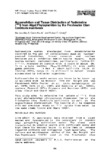Accumulation and tissue distribution of radioiodine (131I) from algal phytoplankton by the freshwater clam Corbicula manilensis

View/Open
Date
1991Page views
521Metadata
Show full item recordCited times in Scopus
- Citations
- CrossRef - Citation Indexes: 5
- Scopus - Citation Indexes: 5
- Captures
- Mendeley - Readers: 12
Share
Abstract
Radioactive wastes discharged from establishments involved in the use of radioisotopes such as nuclear powered industries, tracer research and nuclear medicine are a potential public health hazard. Such wastes contain radionuclides, particularly Iodine-131 (131I), produced in fission with a yield of about 3%. It is a beta emitter (Bmax = 0.61MeV); it also emits gamma photons. It has a short half-life (8.04 d) (Dutton 1975), hence it is difficult to detect unless accumulated by indicator organisms.
Radionuclides in waste waters are known to be taken up by molluscs such as mussels (Van der Borght and Van Puymbroeck 1970; Fowler et al. 1975; Hetherington et al. 1976; Helt et al. 1980; and Sombrito et al. 1982), oyster (Romeril 1971; Cranmore and Harrison 1975) and clams (Cuvin and Umaly 1988).
This study aims to determine the uptake of 131I from algal phytoplankton (Choroococcus dispersus) fed to the freshwater clam Corbicula manillensis as well as the organ/tissue distribution. The results will be compared with our previous study on 131I uptake from water by the same clams (Cuvin and Umaly 1988).
Suggested Citation
Cuvin-Aralar, M. L. A., & Umaly, R. C. (1991). Accumulation and tissue distribution of radioiodine (131I) from algal phytoplankton by the freshwater clam Corbicula manilensis. Bulletin of Environmental Contamination and Toxicology , 47(6), 896-903. https://doi.org/10.1007/BF01689521
Subject
Taxonomic term
Collections
- AQD Journal Articles [1248]



